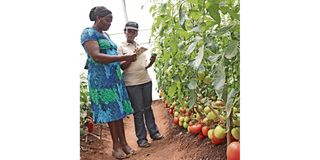Handling tomato plants at flowering stage

Agronomist Linnet Kimari (right) advises Matilda Okhotso, a farmer, on how to grow tomatoes in a greenhouse during a past Nairobi International Trade Fair in 2015. During flowering and fruit development, tomatoes require high potassium, as this helps in fruit development.
What you need to know:
- While spraying tomatoes, one should ensure minimal crop disturbance to avoid interfering with fruit development.
- Spraying is done after scouting for pests and diseases, guided by records maintained as discussed in our previous article.
- During flowering and fruit development, tomatoes require high potassium, as this helps in fruit development.
- During fruiting and flowering, have a regular watering regime to avoid causing stress to the plants. In our next article, we shall focus on the management of pests such as white flies and thrips.
Moses’s tomatoes are now at week 11, where they are flowering and fruiting.
This is a critical stage. Therefore, the farmer needs to take care of the plants to avoid or prevent flower abortion and encourage fruit development.
Fruit and flower abortions are caused by various factors, such as pest infestation. For instance, thrips suck the flower sap.
On Moses's farm, we are currently controlling the thrips by use of chemicals with active ingredient acetamiprid.
At this stage, it’s also important to use chemicals with a low pre-harvest interval to minimise the residue on the fruits.
While spraying, one should ensure minimal crop disturbance to avoid interfering with fruit development.
Minimise stress
Since it is raining, we are also ensuring our crop is well-protected against fungal infections. We are, therefore, spraying fungicides to ensure our tomatoes are not affected by diseases such as blight and powdery mildew as this would lower the quality of the fruits and overall, decrease the expected yields.
Spraying is done after scouting for pests and diseases, guided by records maintained as discussed in our previous article.
Sulphur-based chemicals should be avoided during flowering, as this results in flower abortion. Extreme temperatures also cause the flowers to abort, resulting in big blooms with no tomatoes.
To protect the crops during high-temperature seasons, one should regularly water the plants to minimise stress and regulate soil temperatures.
During the cold conditions and when the temperatures are lower, consider watering the crops in the morning hours as this allows time for the plant to absorb water during the day.
Fruit development
Poor pollination causes the fruits to abort. This can be avoided through use of human-induced pollination by shaking the plant, especially in the greenhouse. Pollination in the greenhouse is thus done by shaking the plant.
It is advisable to perform artificial pollination at midmorning when the temperatures are 21–28 degrees Celsius or there is relative humidity of about 75- 80 as this will enable pollen attachment to the targeted flower part.
When it is too dry, the pollen grains may fall in an untargeted place, and when too cold the pollen grains tend to be sticky and pollination may not take place.
In the open field, one may encourage insect pollination, particularly through bees, by planting bright-coloured flowers on the edges of the farm or along the fence. Farmers with beehives on the farm have an advantage, as this helps in pollination.
During flowering and fruit development, tomatoes require high potassium, as this helps in fruit development.
Regular watering regime
Moses, therefore, top-dressed his crops using potassium nitrates. One may also consider spraying a foliar fertiliser with potassium.
Flower abortion may also be as a result of inadequate micronutrients such as boron. It’s thus important to ensure the plants have sufficient micro-nutrients. This can be top-dressed as a foliar.
At this stage, we are ensuring the crop is well-supported and the props well-maintained so that the developing fruits do not touch the ground as this would make them rot and increase the chances of soil-borne infection, especially during the rainy season.
During fruiting and flowering, have a regular watering regime to avoid causing stress to the plants. In our next article, we shall focus on the management of pests such as white flies and thrips.





